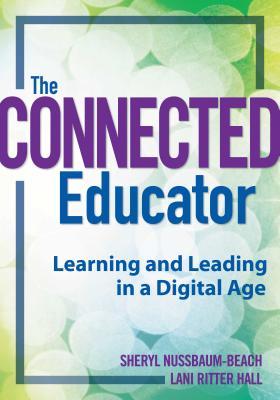Connected Professional Learning
The Connected Educator: Learning and Leading in a Digital Age
By Sheryl Nussbaum-Beach and Lani Ritter Hall
(Solution Tree Press, 2012 – Learn more)
The authors call this book an “interactive professional development experience,” and throughout there are questions to reflect on (as well as some exercises using technology to do, see below.) For somebody looking for a way to become more connected to other educators using digital tools, there’s plenty of meat here.
If you already buy into the value of connecting to other educators and just want some ideas for how to do it, then see chapters 5 and 6 (“using tools” and “building your personal learning community”). Chapters 5 and 6 provide concrete practical tips, including twitter and RSS basics, writing a blog as well as commenting on blogs, and how to decide who to “follow” (make a part of your network).
Short exercises at the end of most chapters will give less technically inclined teachers a chance to experiment with a few online tools. The authors have even provided a website with links to encourage experimentation with these and other free tools. There are quite a few war stories, too, with tangible examples of teachers’ experiences. The authors have also provided lots of references to research, so if you want to read more, the information is readily available. And if you just want to know what a technology term means, there’s a helpful glossary at the back.
 A connected learning model
A connected learning model
Unless you really love taxonomy, skip the chapter on “developing a connected learning model.” Here’s what you need to know: while most of the world uses these terms interchangeably, in this book professional learning communities are within your building, personal learning networks are outside your building, and communities of practice are outside your school but focused on a specific issue for “systemic improvement.”
While the authors begin with talk about creating your own learning network, they talk almost as much about change and reform. Certainly anyone looking for broader change in education will find ideas here.
The authors are not alone in looking at using tools like Twitter to develop personal professional development. Through my own personal learning network, via an email from NCLE (National Council for Literacy Education), I discovered a blog post called, “Can Twitter Replace Traditional Professional Development,” regarding a recent conference at which this topic had been discussed. Then MiddleWeb’s John Norton pointed out this link on a U.S. Department of Education website via his Twitter feed about a book club that included asynchronous and synchronous discussions (now archived) with one of the authors of The Connected Educator. I didn’t search for these resources; they found me.
You can lurk first
One group who might feel less comfortable with all this collaboration might be those who aren’t naturally outgoing. For these teachers, lurking (being present and reading what’s going on, but not participating by tweeting or commenting on blogs, for example) is also valuable and might be an easy first step.
Regardless of how deeply you want to become committed to the constantly available professional development that’s available – free – for anyone with time and access to the Internet, you’ll find something of value here. The authors do a good job of laying out both the why and the how-to of connected learning.
Fran Lo teaches English, Social Studies, and Computer Skills to middle schoolers in Connecticut, where she enjoys blending technology into her classes. One of her other hats is technology guru for teachers and staff. Prior to teaching, she helped people cope with technology in small businesses, health care, and the financial industry. Besides using technology, she writes about her experiences teaching in the blended environment (part face-to-face, part online) using tools like Moodle on her blog Adventures in online teaching. Find her MiddleWeb review of Frank Buck’s Organization Made Easy! Tools for Today’s Teachers here.
In another MiddleWeb review, read Anne Jolly’s take on The Connected Educator.





































